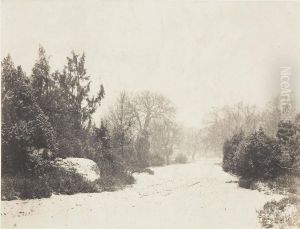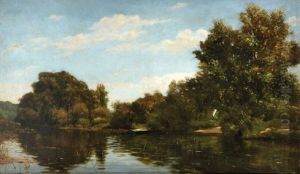Eugene Cuvelier Paintings
Eugène Cuvelier was a French photographer known for his work documenting the rural landscape and forests, particularly the Forest of Fontainebleau, during the mid-19th century. Born in Arras, France, on February 16, 1837, to a family with an artistic background, his father, Adalbert Cuvelier, was a painter and a lithographer who likely influenced his son's artistic inclinations.
In the 1850s, Cuvelier became associated with the Barbizon School, a group of painters who advocated for realism in art and drew inspiration from nature. This affiliation was significant in shaping his approach to photography. Cuvelier's work stood out for its poetic sensitivity to the natural environment and the subtle interplay of light and shadow, which reflected the Barbizon painters' influence and paralleled the works of artists like Jean-François Millet and Théodore Rousseau, with whom he became friends.
Cuvelier was an advocate of the 'plein air' practice, taking his camera into the outdoors to capture the essence of the landscape in its natural state. He worked during a period when photography was beginning to be recognized as an art form in its own right, and his compositions often mirrored the aesthetic considerations of traditional landscape painting.
He married Louise Ganne, the daughter of an innkeeper in the village of Barbizon, which was a central hub for the Barbizon School artists. This connection further solidified his ties with the art movement and allowed him to remain close to the forest that inspired much of his work.
Cuvelier's photographs were not widely known during his lifetime beyond a circle of artists and connoisseurs. He did not seek public recognition and published little. His works were mostly albumen prints, a common photographic process of the time, which involved coating paper with egg white before applying the light-sensitive chemicals.
After his death on October 6, 1900, in Arras, Eugène Cuvelier's contributions to early photography were gradually recognized by later generations. His work has been appreciated for its quiet beauty and technical mastery, and it remains an important part of the history of photography, especially in the context of its relationship with other artistic movements of the time.

